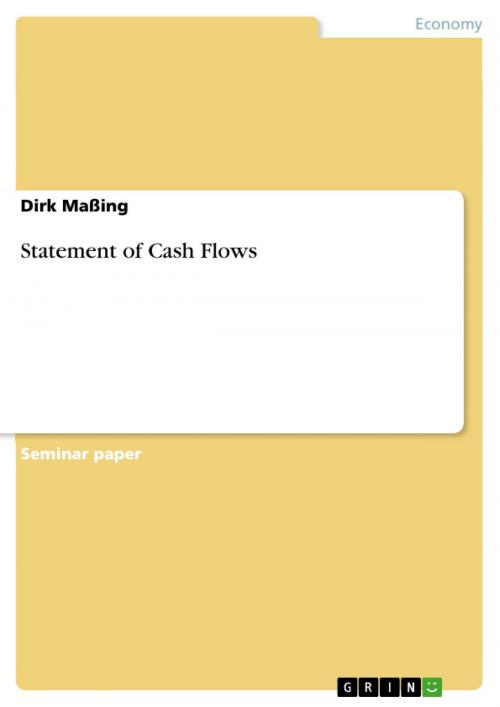| Author: | Dirk Maßing | ISBN: | 9783638168427 |
| Publisher: | GRIN Publishing | Publication: | January 31, 2003 |
| Imprint: | GRIN Publishing | Language: | English |
| Author: | Dirk Maßing |
| ISBN: | 9783638168427 |
| Publisher: | GRIN Publishing |
| Publication: | January 31, 2003 |
| Imprint: | GRIN Publishing |
| Language: | English |
Seminar paper from the year 2002 in the subject Business economics - Accounting and Taxes, grade: 2.0 (B), Technical University of Braunschweig (Institute for Economics), course: International Accounting, 13 entries in the bibliography, language: English, abstract: This seminar paper will give an introduction to the statement of cash flows which is required as part of the financial statements of the US-GAAP. The statement facilitates the analysis of the liquidity, solvency, and financial flexibility of the firm. In german law a statement of cash flows was first introduced in 1998 by the KonTraG 1.2 In accordance with this law (resp. additions to existent law) german companies must publish such a statement when they are listed at the stock market.3 The mission and content of the statement in german law is not defined in German Commercial Code (HGB) but provided by the German Accounting Standards Committee (GASC) with German Accounting Standards No. 2 (GAS 2). It is drawn near IAS 7 of the International Accounting Standards and Statement of Financial Accounting Standards (SFAS) No. 95 of US-GAAP. The Security and Exchange Commission (SEC) sees cash flow statements of IAS 7 and SFAS No. 95 equally and excepts both.4 Because there are not many dierences between SFAS No. 95 and IAS 7 this paper just focuses on the US-GAAP.5 The statement of cash flows is structured in three sections. To set up the first section - called operating activities - you can choose either a direct or and indirect method. Both methods show the same investing and financing cash flows, and both show the reconciliation of net income and net operating cash flows. The main difference is that only the direct method shows the actual operating cash flows such as collections from customers and payments to suppliers. The indirect method uses the reconciliation as its operating activities section, that is why it is also called reconciliation method. When describing the content or giving examples of the statement the indirect method is used always in this paper. In spite of the fact that after SFAS No. 95 the Financial Accounting Standards Board (FASB) is preferring the direct method most companies are using the indirect method. This is because in most cases companies do not store all relevant data in their information system to use the direct method. In the other two sections - investing and financing activities - the direct method must be used.6 In the second part this work will give an overview and is showing details of form and content of the statement of cash flows according to the SFAS No 95, as well as it is presenting information about how to prepare the statement [...]
Seminar paper from the year 2002 in the subject Business economics - Accounting and Taxes, grade: 2.0 (B), Technical University of Braunschweig (Institute for Economics), course: International Accounting, 13 entries in the bibliography, language: English, abstract: This seminar paper will give an introduction to the statement of cash flows which is required as part of the financial statements of the US-GAAP. The statement facilitates the analysis of the liquidity, solvency, and financial flexibility of the firm. In german law a statement of cash flows was first introduced in 1998 by the KonTraG 1.2 In accordance with this law (resp. additions to existent law) german companies must publish such a statement when they are listed at the stock market.3 The mission and content of the statement in german law is not defined in German Commercial Code (HGB) but provided by the German Accounting Standards Committee (GASC) with German Accounting Standards No. 2 (GAS 2). It is drawn near IAS 7 of the International Accounting Standards and Statement of Financial Accounting Standards (SFAS) No. 95 of US-GAAP. The Security and Exchange Commission (SEC) sees cash flow statements of IAS 7 and SFAS No. 95 equally and excepts both.4 Because there are not many dierences between SFAS No. 95 and IAS 7 this paper just focuses on the US-GAAP.5 The statement of cash flows is structured in three sections. To set up the first section - called operating activities - you can choose either a direct or and indirect method. Both methods show the same investing and financing cash flows, and both show the reconciliation of net income and net operating cash flows. The main difference is that only the direct method shows the actual operating cash flows such as collections from customers and payments to suppliers. The indirect method uses the reconciliation as its operating activities section, that is why it is also called reconciliation method. When describing the content or giving examples of the statement the indirect method is used always in this paper. In spite of the fact that after SFAS No. 95 the Financial Accounting Standards Board (FASB) is preferring the direct method most companies are using the indirect method. This is because in most cases companies do not store all relevant data in their information system to use the direct method. In the other two sections - investing and financing activities - the direct method must be used.6 In the second part this work will give an overview and is showing details of form and content of the statement of cash flows according to the SFAS No 95, as well as it is presenting information about how to prepare the statement [...]















